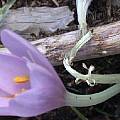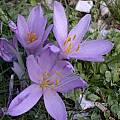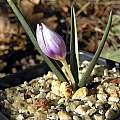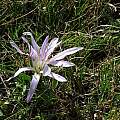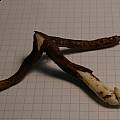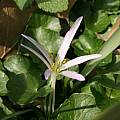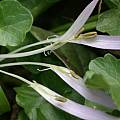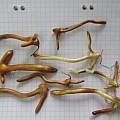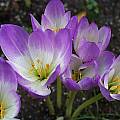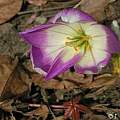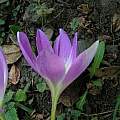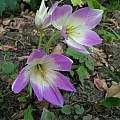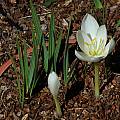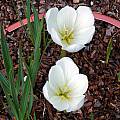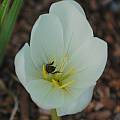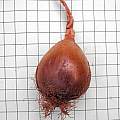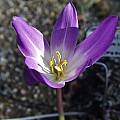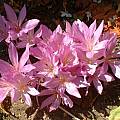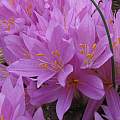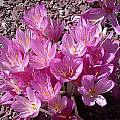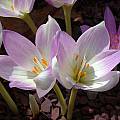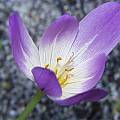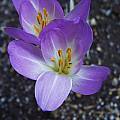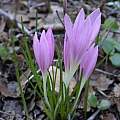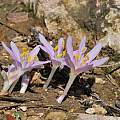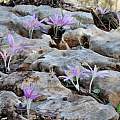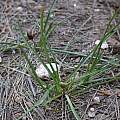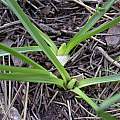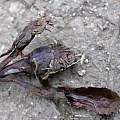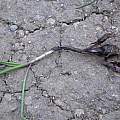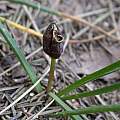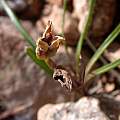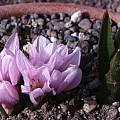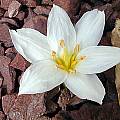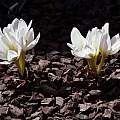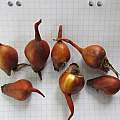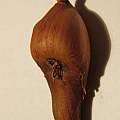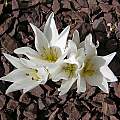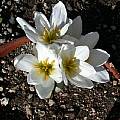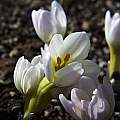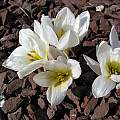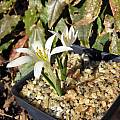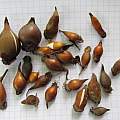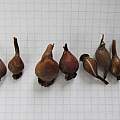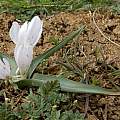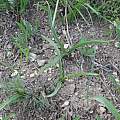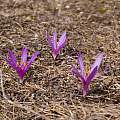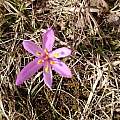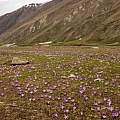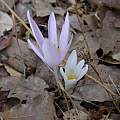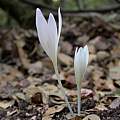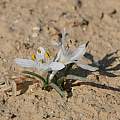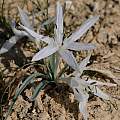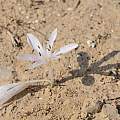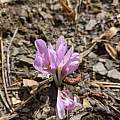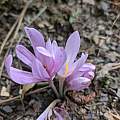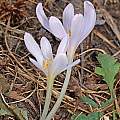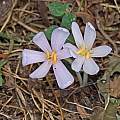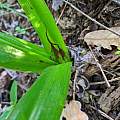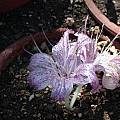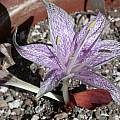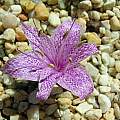Colchicum species s through z are found on this wiki page
Colchicum Hybrids - Colchicum a-h - Colchicum i-r - Colchicum index
Colchicum sanguicolle K.Perss. is a species, little known to cultivation, that grows in the mountains of southwestern Turkey and is distinguished by the deep red prophyll (sheathing leaf) visible in one of the photos just above the soil surface. It grows among rocks and in short grass, but the largest colonies appear to be in duff just downhill and outside the drip line of large Cedrus libani (cedars). It is a medium-sized colchicum about 10 cm tall in flower. Photos by Jane McGary.
Colchicum serpentinum Woronow ex Miscz. is a spring flowering species from Turkey. Height: about 10 cm. Photo from John Lonsdale.
Colchicum sibthorpii Baker see Colchicum bivonae Guss.
Colchicum soboliferum (C.A.Mey.) Stef., syn. Merendera sobolifera C.A.Mey., is native from the Balkan Peninsula to Afghanistan. It flowers in late winter or early spring. The first photo below from iNaturalist was taken by Sabina E. Vlad in Romania in March and shared under a CC BY license. The next three photos were taken by Jim McKenney who wrote: "It was in bloom on March 15, 2008 in the zone 7 Montgomery County, Maryland, USA, garden of Jim McKenney. The first image (note: of three) shows the unusual corm (against a quarter inch grid): it resembles a cluster of Gloriosa corms. In the middle image if you look carefully you can see under the colored portions of the bloom the basal portions of each tepal; they look like threads. This is the salient characteristic of the genus Merendera (note: now included in Colchicum. Just under the colored portion of the tepal they are hooked together in this species. I gently pulled the tepals apart to get the third image, where you can see the "hooks" which hold them together." The last photo by Dr. Dimitri Zubov is another photo of the strange looking corms.
Colchicum speciosum Steven is a fall blooming popular species native to Turkey and the Caucasus where it is found in meadows and light woodland. Flowers appear long before the leaves with flower color from pinkish purple to deep purple sometimes with a white zone in the throat. Photo by Arnold Trachtenberg.
A form from Northern Turkey, once considered a species, but now included in Colchicum speciosum, Colchicum bornmuelleri Freyn has narrower leaves and purplish anthers. Photos by Janos Agoston of plants grown as C. bornmuelleri.
Colchicum speciosum 'Album' has huge pure white goblets tinged green in the throat and gets high praise as possibly one of the best autumn bulbs for the garden. Photos by Mary Sue Ittner of plants growing in a container in a raised bed with Babiana leaves showing. The third picture shows a bee rolling around in the flower. The last shows the corm on a 1 cm grid.
Colchicum speciosum 'Atrorubens' is richly colored. Photo by Arnold Trachtenberg
Colchicum ssp. shows unidentified species. The first two photos by Angelo Porcelli are of what was thought to be the sterile hybrid Colchicum byzantinum, but is apparently not that species. One guess is that it could be Colchicum cilicicum. These plants do set a few seeds sporadically. It is a strong grower, which multiplies fast with its large oval bulbs. Leaves are very large too, with a well visible pseudostem. The next two photos by John Lonsdale are of two unidentified species. The last two photos from Arnold Trachtenberg were received as Colchicum umbrosum, but are not that species.
Colchicum stevenii Kunth is a species from the Eastern Mediterranean. The leaves emerge after or during flowering. Height: 8 cm. All photos of wild plants in situ by Gideon Pisanty. The first 4 photos are of the flowers. The next 2 are of the leaves.
The first two photos are of the corms and the last two of the fruit.
Colchicum szovitsii Fisch. & C.A.Mey. is a spring-flowering species native to the area of Turkey, Iran, and the Caucasus. Flowers may be pink or white. Height: to about 20 cm. The first photo from Jane McGary shows a pink form grown from wild-collected seed from Turkey photographed in early February in a bulb frame in Oregon. The next two photos were taken by John Lonsdale. The last photo of corms from Armenia was taken by Dr. Dimitri Zubov.
Colchicum szovitsii ssp. brachyphyllum (Boiss. & Hausskn.) K.Perss. is one of two subspecies. Photo of corm from Israel was taken by Dr. Dimitri Zubov.
Cultivars 'Snow White', 'Tivi', and 'Vardaovit' are shown below. Photos by John Lonsdale, Jane McGary, and Arnold Trachtenberg. Jane writes "'Tivi'is a white selection found by Janis Ruksans. According to one description, this species has dark anthers, but these plants have yellow anthers; nevertheless I am accepting the collectors' identifications for them. Photographed in early February in a bulb frame in Oregon"
Colchicum tenorei Parl. see Colchicum cilicicum (Boiss.) Dammer
Colchicum trigynum (Steven ex Adams) Stearn, syn. Bulbocodium trigynum Steven ex Adams, Merendera trigyna (Steven ex Adams) Stapf, and Merendera candidissima Miscz. ex Grossh., is native to Turkey, Iran and the Caucasus. The first photo is from John Lonsdale. The second photo is of the corms from the Azerbaijan Democratic Republic and is provided by Dr. Dimitri Zubov. The third photo of what was provided as Merendera trigyna, a possible synonym, was taken by Dr. Dimitri Zubov
Photos from iNaturalist were taken by А.А. Теймуров in Russia in March and April and by Pavel Odinev in Georgia in May and shared under CC BY-NC and CC BY-SA licenses.
Colchicum troodi Kotschy is a small species native to Israel. Height: about 20 cm. Photos were taken by Gideon Pisanty.
Colchicum tuviae Feinbrun is from Israel. Leaves emerge during or after flowering. Photos taken by Gideon Pisanty.
Colchicum umbrosum Steven is a small species from Ukraine, Turkey and Romania with white or pale pink flowers with yellow anthers that flowers late summer early fall without leaves. Segments are 1.5-2.5 cm long and .5 cm or less wide so they appear starry when open." Height: 12 cm. Photos from iNaturalist were taken by Svetlana Bogdanovich and vlad50 in Ukraine (flowers in August and September and leaves and fruit in May) and shared under a CC BY-NC license.
Colchicum variegatum L. from southern Greece and southwestern Turkey is regarded as a rather tender species. It is distinguished by its very strong tessellation (checkerboard marking) and is the parent of Colchicum × agrippinum, which is hardier. Height: about 15 cm. The first two photos from Jane McGary show (1) a bulb purchased from a European source and (2) a plant grown from seed purchased from the Archibalds. The last photo was taken by John Lonsdale.
Colchicum Hybrids - Colchicum a-h - Colchicum i-r - Colchicum index
